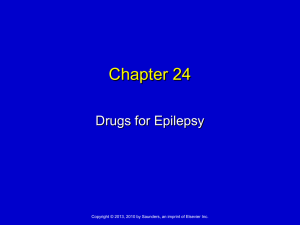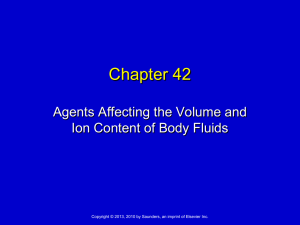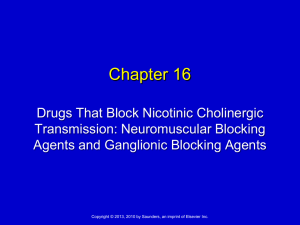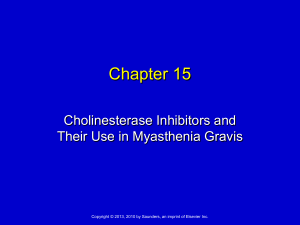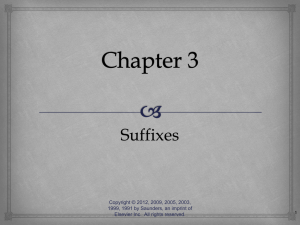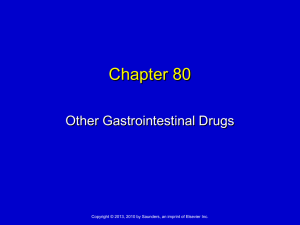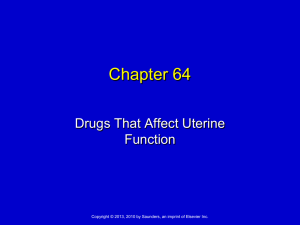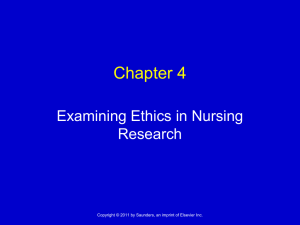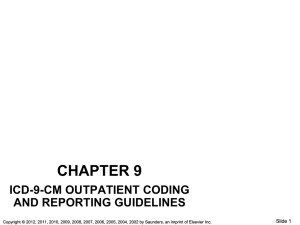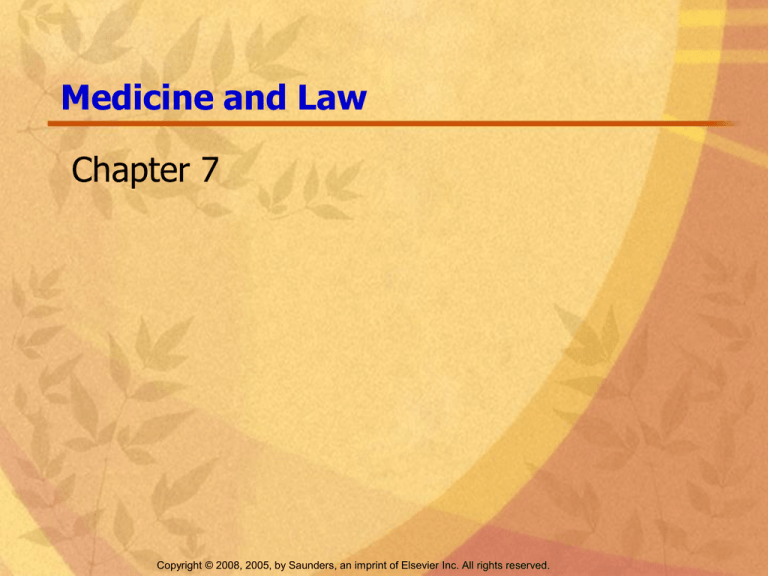
Medicine and Law
Chapter 7
Copyright © 2008, 2005, by Saunders, an imprint of Elsevier Inc. All rights reserved.
Introduction
The study of law and medicine provokes interesting case
studies and complex decisions.
Ethics and law go hand in hand when applied to the
medical profession.
Copyright © 2008, 2005, by Saunders, an imprint of Elsevier Inc. All rights reserved.
Slide 2
This Chapter will Examine
The types and categories of law
The law as it relates to medical professional liability
The elements of a valid contract
The court process
Types of negligence
Issues regarding consent
Laws affecting medical practice
Copyright © 2008, 2005, by Saunders, an imprint of Elsevier Inc. All rights reserved.
Slide 3
Types of Laws
Act—passed by Congress
Statutes—enacted by state legislatures
Ordinances—created and enacted by local governments
Precedents—previous judicial decisions that influence a
current ruling
Copyright © 2008, 2005, by Saunders, an imprint of Elsevier Inc. All rights reserved.
Slide 4
Criminal Law
Criminal law deals with offenses against the state or
government.
Copyright © 2008, 2005, by Saunders, an imprint of Elsevier Inc. All rights reserved.
Slide 5
Basic Categories of Criminal Law
Misdemeanors
Minor crimes, punishable by a fine or imprisonment in a
city or county jail for 1 year or less
Vary from state to state
Often classified as class A, class B, and class C
depending on the seriousness of the crime
Copyright © 2008, 2005, by Saunders, an imprint of Elsevier Inc. All rights reserved.
Slide 6
Basic Categories of Criminal Law
Felonies
Major crimes, such as murder, rape, and burglary
Punishable by a more stringent sentence than are
misdemeanors
Can receive probation, imprisonment for 1 year or more
Divided into first degree, second degree, and third
degree
Copyright © 2008, 2005, by Saunders, an imprint of Elsevier Inc. All rights reserved.
Slide 7
Basic Categories of Criminal Law
Treason
Most serious crime
Attempting to overthrow the government
Copyright © 2008, 2005, by Saunders, an imprint of Elsevier Inc. All rights reserved.
Slide 8
Civil Law
Civil law involves acts that are not criminal in nature but
involve relationships among individuals, organizations, or
government agencies.
Copyright © 2008, 2005, by Saunders, an imprint of Elsevier Inc. All rights reserved.
Slide 9
Basic Categories of Civil Law
Tort Law
Provides remedies for individuals who have been
harmed by the wrongful acts of others
Copyright © 2008, 2005, by Saunders, an imprint of Elsevier Inc. All rights reserved.
Slide 10
Proving Breach of Tort Law
Four Elements
1.
Duty - Legal duty to act was present
2.
Derelict – Duty to act was breached
3.
Direct Cause - Failure to act caused injury or damage
4.
Damages - Injury or damage was a result of the
breach of duty
Note: Medical professional liability falls into the category of
tort law.
Copyright © 2008, 2005, by Saunders, an imprint of Elsevier Inc. All rights reserved.
Slide 11
Basic Categories of Civil Law
Contract Law
Contracts are agreements that create an obligation.
Can be oral or written to be binding.
Copyright © 2008, 2005, by Saunders, an imprint of Elsevier Inc. All rights reserved.
Slide 12
Basic Categories of Civil Law
Administrative Law
Involves regulations set forth by governmental agencies.
IRS, SSA, USCIS, CMS are examples of agencies that
use administrative law.
Copyright © 2008, 2005, by Saunders, an imprint of Elsevier Inc. All rights reserved.
Slide 13
Anatomy of Medical Professional Liability
Lawsuits
Most medical professional liability lawsuits stem from a
breach of trust between the physician and patient.
Copyright © 2008, 2005, by Saunders, an imprint of Elsevier Inc. All rights reserved.
Slide 14
Valid Legal Contracts
Four Essential Elements:
1.
Manifestation of assent
2.
Legal subject matter
3.
Legal capacity to enter into a contract
4.
Consideration
Copyright © 2008, 2005, by Saunders, an imprint of Elsevier Inc. All rights reserved.
Slide 15
Physician-Patient Relationship
The physician-patient relationship is considered
contractual as a result of three events:
1.
Physician invites an offer by establishing availability.
2.
Patient accepts the invitation any arrives for
treatment.
3.
Physician accepts patient and begins treatment.
Copyright © 2008, 2005, by Saunders, an imprint of Elsevier Inc. All rights reserved.
Slide 16
Implied Contract
The physician will treat the patient using reasonable
care.
Physician possesses a degree of knowledge, skill, and
judgment that is reasonably expected of any physician in
the same area.
Copyright © 2008, 2005, by Saunders, an imprint of Elsevier Inc. All rights reserved.
Slide 17
Protection against Abandonment Charges
Notify a patient in writing if withdrawing from medical care, stating:
Professional medical care is being discontinued
Copies of medical records will be sent to another physician on
request
Patient should seek medical care immediately
Highest state courts other than appellate courts
The U.S. District Court handles federal civil and criminal matters
Eighty to 90 cases are chosen to be heard by the court.
Copyright © 2008, 2005, by Saunders, an imprint of Elsevier Inc. All rights reserved.
Slide 18
Medical Professional Liability
Also known as medical malpractice
Much more easily prevented than defended
Commonly caused by a deterioration of the patientphysician contract
Copyright © 2008, 2005, by Saunders, an imprint of Elsevier Inc. All rights reserved.
Slide 19
Negligence
The performance of an act that a reasonable and
prudent physician would not perform, or the failure to
perform an act that a reasonable and prudent physician
would perform.
If the patient contributes to the worsening of his or her
condition, he or she is guilty of contributory negligence.
Copyright © 2008, 2005, by Saunders, an imprint of Elsevier Inc. All rights reserved.
Slide 20
Three Classifications of Negligence
Malfeasance: The performance of an act that is wholly
wrongful and unlawful.
Misfeasance: The improper performance of a lawful act.
Nonfeasance: The failure to perform an act that should
have been performed.
Copyright © 2008, 2005, by Saunders, an imprint of Elsevier Inc. All rights reserved.
Slide 21
Consent
Implied: In most cases, this type of consent is apparent
since the patient sought the services of the physician
e.g., The patient extends his or her arm for an injection or
phlebotomy
Informed:
Written consent for a surgical procedure or other
treatment
Copyright © 2008, 2005, by Saunders, an imprint of Elsevier Inc. All rights reserved.
Slide 22
Elements of Informed Consent
Patient diagnosis, if known
Nature and purpose of proposed treatment or procedure
Risks and benefits of a proposed treatment or procedure
Alternative treatments or procedures
Risks and benefits of alternative treatments or
procedures
Risks and benefits of not receiving any treatments or
procedures
Copyright © 2008, 2005, by Saunders, an imprint of Elsevier Inc. All rights reserved.
Slide 23
Good Samaritan Law
In the event that a patient has NOT provided consent
and is in need of emergency assistance, the provider
will be protected under the Good Samaritan Act
Volunteer will not be held liable for any civil damages
that occur as a result of their efforts to provide
emergency care
Copyright © 2008, 2005, by Saunders, an imprint of Elsevier Inc. All rights reserved.
Slide 24
Confidentiality
Confidentiality is the most important trust that the patient
places in the hands of the physician. Breach of patient
confidentiality is grounds for immediate dismissal.
Copyright © 2008, 2005, by Saunders, an imprint of Elsevier Inc. All rights reserved.
Slide 25
Legal Disclosures
Physicians must report certain statistics.
Births
Deaths
Injuries as a result of violence
Accidental and/or suspicious deaths
Sexually transmitted diseases
Child and/or elder abuse
Copyright © 2008, 2005, by Saunders, an imprint of Elsevier Inc. All rights reserved.
Slide 26
Patient Self-Determination Act
This act requires healthcare facilities to develop and
maintain written procedures so that patients receive
information about:
living wills.
durable powers of attorney.
advance directives.
Copyright © 2008, 2005, by Saunders, an imprint of Elsevier Inc. All rights reserved.
Slide 27
Patient’s Bill of Rights
Goals:
Strengthen consumer confidence by ensuring the
healthcare system is fair and responsive to consumer
needs
Reaffirm the importance of a strong relationship
between patients and healthcare providers
Reaffirm the critical role consumers play in safeguarding
their health
Copyright © 2008, 2005, by Saunders, an imprint of Elsevier Inc. All rights reserved.
Slide 28
Controlled Substances Act
Enforced by DEA
Regulates writing, telephoning, and refilling of
prescriptions
Rules vary depending on which schedule the drug is
classified under
Copyright © 2008, 2005, by Saunders, an imprint of Elsevier Inc. All rights reserved.
Slide 29
Drug Schedules
Schedule I
Highly addictive
Schedule II
High abuse potential
Schedule III
Lower abuse potential
Schedule IV
Still lower abuse potential
Schedule V
Lowest abuse potential but still warrants control
Copyright © 2008, 2005, by Saunders, an imprint of Elsevier Inc. All rights reserved.
Slide 30
Uniform Anatomical Gift Act
Basic Provisions
Any person of sound mind who is 18 or older can give all
or part of his or her body after death for research,
transplantation, or placement in a tissue bank.
A donor’s valid statement of gift is paramount to the
rights of others unless state law intercedes.
If a donor has not indicated an intent to donate,
survivors may do so in a specified order of priority.
Copyright © 2008, 2005, by Saunders, an imprint of Elsevier Inc. All rights reserved.
Slide 31
Health Insurance Portability and
Accountability Act (HIPAA)
Provisions
Title I—Insurance Reform
Title II—Administration Simplification
The law provides for security and confidentiality
guarantees for the individual patient, emphasizing
patient privacy.
Copyright © 2008, 2005, by Saunders, an imprint of Elsevier Inc. All rights reserved.
Slide 32
Benefits of HIPAA
Lower administrative costs
Increased accuracy of data
Increased patient and consumer satisfaction
Reduced revenue cycle time
Improved financial management
Copyright © 2008, 2005, by Saunders, an imprint of Elsevier Inc. All rights reserved.
Slide 33
Medical Practice Acts
Purpose:
To define what is included in the practice of medicine
within each state
To govern the methods and requirements of licensure
To establish the grounds for suspension or revocation of
license
Copyright © 2008, 2005, by Saunders, an imprint of Elsevier Inc. All rights reserved.
Slide 34

